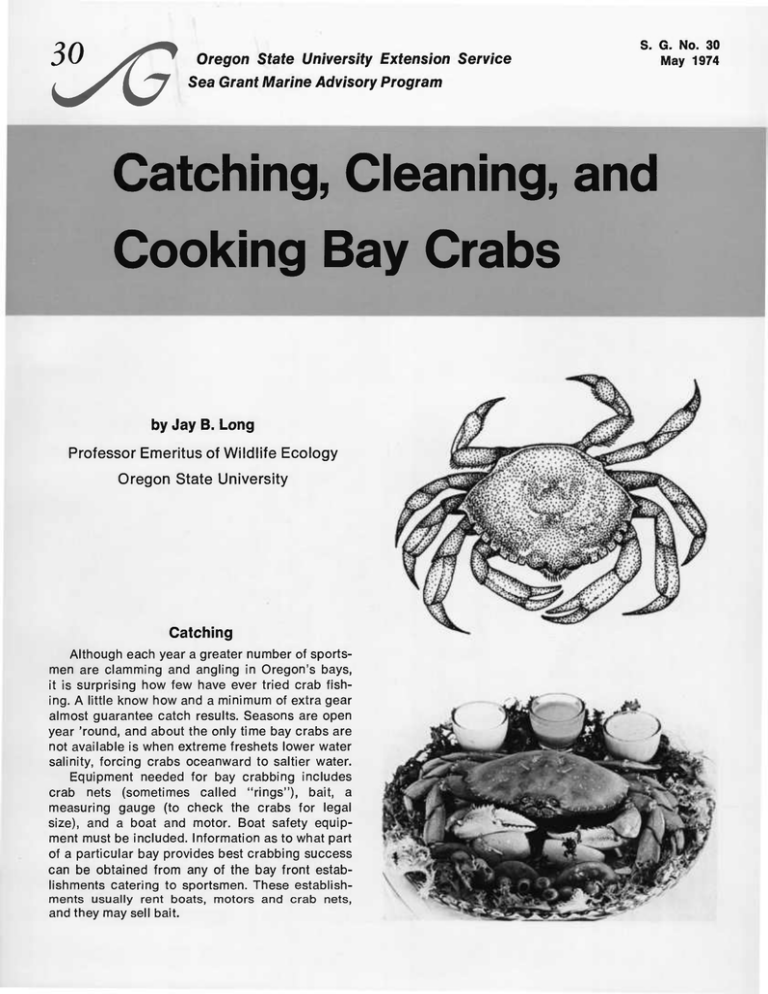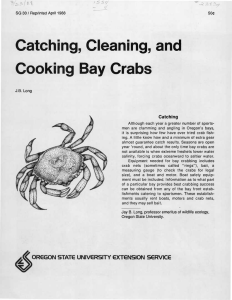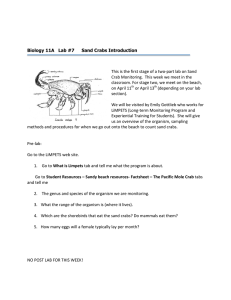'yc Catching, Cleaning, and Cooking Bay Crabs Oregon State University Extension Service
advertisement

'yc
Oregon State University Extension Service
Sea Grant Marine Advisory Program
s. G. No. 30
May 1974
Catching, Cleaning, and
Cooking Bay Crabs
by Jay B. Long
Professor Emeritus of Wildlife Ecology
Oregon State University
Catching
Although each year a greater number of sportsmen are clamming and angling in Oregon's bays,
it is surprising how few have ever tried crab fishing. A little know how and a minimum of extra gear
almost guarantee catch results. Seasons are open
year 'round, and about the only time bay crabs are
not available is when extreme freshets lower water
salinity, forcing crabs oceanward to saltier water.
Equipment needed for bay crabbing includes
crab nets (sometimes called "rings"), bait, a
measuring gauge (to check the crabs for legal
size), and a boat and motor. Boat safety equipment must be included. Information as to what part
of a particular bay provides best crabbing success
can be obtained from any of the bay front establishments catering to sportsmen. These establishments usually rent boats, motors and crab nets,
and they may sell bait.
An open top crab net (see illustration) consists of two large metal rings connected by mesh
netting on sides and bottom. A pulling rope is
attached to the top ring. Floats and a bait holder
or bait bag complete the equipment.
Crab rings lie flat on the bay bottom when
dropped. They form a mesh-type net or basket
which holds the crabs as the ring is pulled up.
Any type of fresh meat may be used for bait.
Crabs are attracted by odor; and fresh fish carcasses, which are usually a by-product of any bay
fishing excursion, are excellent. Some crabbers
prefer cockle clams (with shells cracked) or whole
oily fish, such as herring, for bait.
Crabbing should be correlated with the tides,
and it is nearly always best at about slack tide—
either low or high. At slack, crabs can move easily
Left—Crab net showing rings, line, floats and bait bag.
Below—Crab fisherman returns with catch.
without bucking strong tidal currents and seem
to come more readily to the odor trail from the bait.
Best days for crabbing (and also for bay fishing)
are those on which a minimal difference exists
between high and low tidal stages. Tide table are
available free at most sporting goods stores.
Most bay crab fishing parties use several open
top nets when crabbing. These nets are usually
placed in or near the channel at intervals of 75 to
100 yards. Nets should be laid out in a straight
line parallel to—and not across—the channel so
that passing boats may easily maneuver to avoid
hitting ropes and floats. {This is important.)
Nets should be pulled every 20 to 30 minutes—
depending upon how fast the crabs are coming
to the bait. While waiting, crabbers may engage
in bottom fishing to insure an adequate supply of
fresh crab bait. Floats should always be ap-
proached against the tide. As the boat nears the
net, floats are picked up and the line is gathered
in. Actual pulling should not be begun until the
boat is almost directly over the net. This is important; if the net is not pulled straight up—and
fast—the larger crabs may escape over the top
ring.
Probably the best way to handle crabs is by
quickly grasping one of the rear legs or the rear
central portion of the shell. Work fast—crabs have
a relatively slow reaction time. Female and softshelled crabs should be thrown back and only
legal-sized, hard-shelled males retained.
As crabs grow, they periodically shed and replace the exoskeleton. A soft-shelled crab is one
that has recently shed its shell. It can be recognized by the very light color of the shell (bluishwhite instead of yellowish-brown) and by the ex-
Puliing in a crab net.
/Above—Female crab (top) has a wide sternum or
shell flap on the underside. Male (bottom) has a
narrow sternum.
treme softness or fragility of the shell. Such crabs
are edible, but the flesh is soft and watery, and
the shells contain little meat. The shell flap
(sternum) on the underside of the female crab is
broad and on the male is very narrow.
Below—Measuring a crab
Making Crab Rings
*
«
•*. *.
. 11^
•L
- >^i
'C-
t&
%
"^
i
4
^i
lp
^
' H>;
--\^
--* - "4l0*
v.-;.-^;
v ->.
■•"_ i i
-I**-
Although crab rings or nets may usually be
rented, many sportsmen—after finding how much
fun and how successful bay crabbing can be—
prefer to make their own. The following directions
are for making a crab net that closely resembles
the nets used by commercial bay crabbers.
Rings:
Top ring: 30 inches in diameter, of s/8-inch steel
rod or cable
Bottom ring: 26 inches in diameter, of 3/8-inch
steel rod or cable
Total weight of rings should be at least 8 to
10 pounds or nets will have a tendency to drift
in heavy current and may be lost. Weight may be
added to lightweight rings by clamping on strips
of lead.
Rings should be covered to prevent contact
with salt water. This should be done before netting
or ropes are attached. One method generally used
is to wrap the rings tightly with strips of rubber
innertubing or plastic tape. A better way (we think)
is to wrap with fiberglas tape. This is then impregated or sealed with resinote, making a smooth,
watertight job.
colored so that it may be easily located and large
enough to remain afloat during normal tidal current
flows.
Side netting:
The side netting should be 16 inches in depth
(between top and bottom rings), of Vs-inch diameter
cotton, nylon, or linen net twine with approximately
4-inch stretch mesh measurement.
Shuttle outfits for weaving nets, complete with
instructions, are available at most sporting goods
stores. As a substitute, old tennis netting may be
used. Tennis netting is water resistant and is quite
durable. But its comparatively heavy cord and fine
mesh set up considerable water resistance which
makes rings hard to pull.
Bait holders:
Bait bag: A woven bait bag of not over 1-inch
width mesh is essential if cockle clams or small
fish such as herring are to be used for bait. The
bag is attached to each side of the top net ring
by means of wire hooks and rubber bands, so that
it is held in the center of the net.
Wire bait holder: This type of bait holder resembles a large safety pin. It works well when
larger fish carcasses are used for bait. It is attached to the middle of the net bottom. The bait
is secured by running the open end of the safety
pin wire through the mouth and gills of the fish
and then closing the snap. A wire curtain rod
holder may be used for this purpose—or a larger
bait holder may be fashioned from coat hanger
wire.
A home-made crab net has two important advantages: availability and comparatively low-cost.
The sportsman who goes crabbing with his own
gear eliminates the possibility of returning home
disappointed because he is unable to rent a net;
commercial nets are not always available. The
cost of a home-made net is less than the cost of
renting commercial nets for 10 to 15 trips.
The use of several nets at a time, rather than
just one, obviously increases the chances of crabbing success.
Bottom netting:
Galvanized chicken wire with 2-inch mesh is
excellent for the bottom of the net. It is inexpensive, is simple to install, and it pulls easily.
Ropes:
Ring ropes: Three ropes of equal length, Vi- to
3
/8-inch in diameter, are attached to the top ring.
These lead to a small 1-inch metal ring in the
center—into which the pulling rope is tied.
Pulling rope: The pulling rope leads from the
junction of the ring ropes to the safety floats. This
rope should be about 40 feet long and 3/8-inch in
diameter. Rope of smaller diameter is too hard
to hold while pulling and rope of larger diameter
sets up too much resistance to the current. Good
quality manila rope works well.
Float rope: The float rope leads from the safety
floats to the large surface float. This rope should
be at least 15 feet in length. Since it is not used
for net pulling, sash cord of 1/4-inch or smaller
diameter is satisfactory.
Floats:
Net float: The net float is placed at the junction
of the net ropes and pulling rope. This float holds
the net ropes up away from the bait while the
net is fishing on the bay bottom. One wooden float
3 to 4 inches in diameter and 6 to 7 inches long—
or two smaller ones—will suffice.
Safety floats: Safety floats are placed at the
junction of the pulling and float ropes. These floats
help to pinpoint the vertical location of the ring
and also serve as safety floats in case the large
net marker float is lost. Three 4- to 7-inch floats are
satisfactory here.
Net marker float: A large wooden float is commonly used. A plastic gallon jug with a screw-on
top works well. This net float should be brightly
Baiting a crab ring with a carp carcass.
Remove back by forcing edge of the shell against any solid object.
Freshly caught crabs are most easily and
quickly cleaned if this is done before they are
cooked. The cleaning procedure takes less than
30 seconds per crab.
Cleaning prior to cooking eliminates visceral
taste, facilitates salt penetration in the body meat
and increases the keeping qualities of the crab
meat.
The cleaning procedure is as follows:
1. Remove the carapace or back of the crab
by forcing edge of the shell against any
solid object.
2. Break crab in two by folding it like a book—
first up and then down.
3. Shake out viscera from each half.
4. Pull off gill filaments. Nothing remains but
shell and edible meat.
Cooking
Crabs should be cooked as soon as practical
after cleaning. Add about 3 to 5 ounces of salt
per gallon of fresh water—or 2 ounces of salt per
gallon of salt water. Bring the salty water to a
boil, drop crabs in and time for 12 to 15 minutes
after the water again starts boiling. Remove crabs
from water and immediately immerse them or
spray them with cold water until cool. This stops
the cooking process, prevents drying and shrinkage of the meat, and tends to prevent meat from
adhering to the shell.
Regulations
As regulations for catching crabs may vary
from year to year, it is important that sportsmen
check the current regulations. These are available
from the Fish Commission of Oregon, Portland,
Oregon 97201 or from sporting goods stores and
boat rental outlets.
Above—Fold to break in half and shake out viscera
from each half.
Below—Complete cleaning operation by pulling
off gill filaments.
S.G. 30 replaces an earlier Extension Service publication, EC 744, by the same author.
5-74/ 10M
C^S
A
G?
$£3 t& to
EXTI
DON
Extension Service, Oregon State University, Corvallis, Joseph R. Cox, director. This
publication was produced and distributed in furtherance of the Acts of Congress of
May 8 and June 30, 1914. Extension work is a cooperative program of Oregon
State University, the U.S. Department of Agriculture, and Oregon counties. Extension's Marine Advisory Program is supported in part by the Sea Grant Program,
National Oceanic and Atmospheric Administration, U.S. Department of Commerce.


